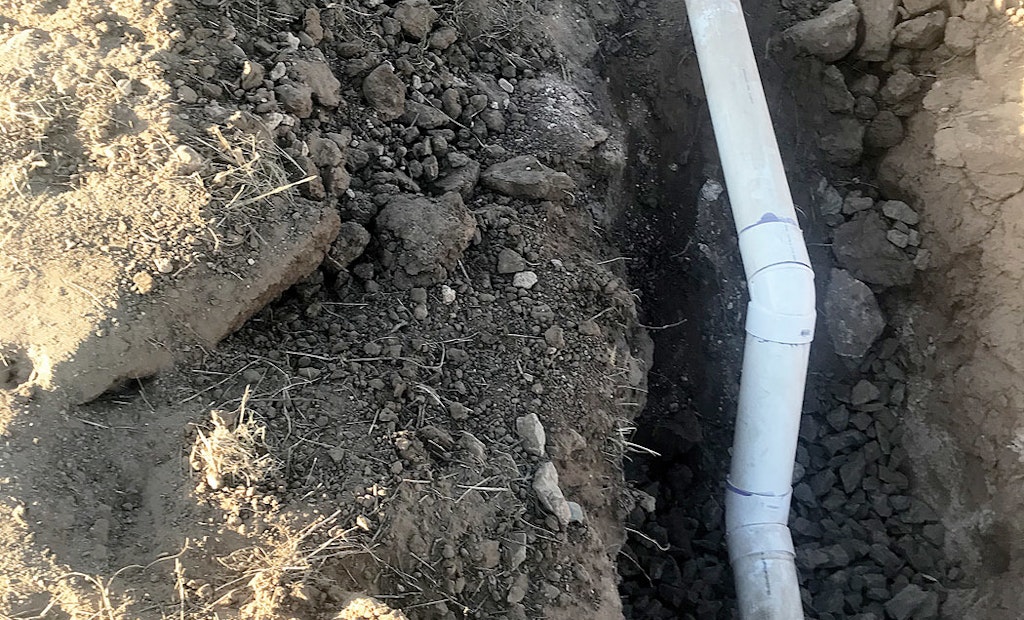Interested in Education/Training?
Get Education/Training articles, news and videos right in your inbox! Sign up now.
Education/Training + Get AlertsOver the spring and summer, we received more than the usual number of questions, comments and examples regarding questionable installing practices. All of us had a little extra time to think about installations and potential problems. A colleague of ours sent a couple photographs to illustrate problems or issues he has seen with piping from the outlet of septic tanks.
Even though we have discussed proper placement of piping before, these images show it is a topic that should always be discussed in any basic installation training.
Photo A shows an unsupported pipe running out of the septic tank and into an excavated trench before coming to 45-degree elbows to step the piping down in elevation to compensate for a slope break. Photo B shows the unsupported pipe coming from the septic tank outlet.
If the piping is left in this condition and the system backfilled, then the soil around the supply pipe will settle, causing the pipe to be placed at an angle restricting flow out of the tank. This can cause backups in the tank and into the house. Another potential problem is the pipe itself will shear off at the outlet. Sewage will enter the ground at the point where the pipe breaks, not making it to the soil treatment part of the system. This will lead to sewage surfacing in the area of the break.
Breaking bad
Without proper support where the elbow is placed, the soil will settle and there will be a tendency for the pipe to separate or break when effluent runs through the pipe. This will interrupt sewage flow to the soil treatment part of the system, resulting in surfacing in the yard.
If the pipe is not properly supported, a bend or dip in the piping will occur along the straight section from the tank to the first elbow. This is where plugging or freezing can occur. Remember that the first rule of supply pipes is that there should be nothing but air in the piping between sewage-generating events. If water or solids are stopped at dips in the pipe, there will be plugging problems.
When installing supply pipes out of any tank, care should be taken to reduce the space between the tank and natural soil the piping crosses. Schedule 40 plastic pipe should be used over the excavation and the soil backfill under the pipe should be compacted to its original soil density. This condition should extend a minimum of 3 feet beyond the edge of the tank excavation.
Piping running in the excavated trench needs to be properly laid and bedded. Often additional bedding material is not needed if the trench is not overexcavated. However, if there is bedrock, hardpan, a large percentage of rocks or other debris in the trench bottom, the piping should be bedded. The photos show evidence of overexcavation and presence of rocks, so bedding should be used to support the piping. If bedding is needed, a well-graded, compacted granular material (sand) should be used.
Backfill basics
Next, a layer of material should be provided from the top of the bedding to the midpoint of the piping, and it should be tamped around the pipe. Final backfilling should take place in two stages and tamped, and the soil at the top of the trench should be slightly mounded to provide for settling and to avoid having a depression over the pipe where water can collect due to surface runoff. Another comment on final backfilling: Backfill cannot be done with organic soils, frozen soils or soils with rock larger than 1.5 inches in diameter within 6 inches of the pipe. ASTM standards for laying pipe should be followed.
Similarly, the soil in the area of the pipe elbows must be compacted to original density and backfilled in stages with tamping and compaction. In the photos, the piping in the area of the elbows is not supported at all. The pipe will likely break during backfill. Even if it does not break initially, it will over time as the soil settles away underneath and water moves through the pipe. It is a good policy to also provide a clean-out where there are slope breaks to provide access to clean the piping if necessary.
Everything we’ve mentioned applies to piping at the tank inlet as well. It needs to be supported and properly bedded. Having clean-outs for even straight-line pipes laid on grade is more important since wastewater from the house will contain larger solids than at the outlet.






